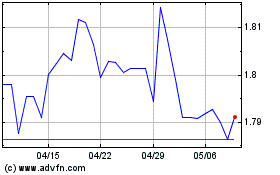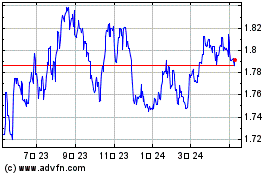Australian Dollar Slides After RBA Rate Decision
2024年3月19日 - 12:52PM
RTTF2
The Australian dollar weakened against other major currencies in
the Asian session on Tuesday, after the Reserve Bank of Australia
decided to keep its benchmark interest rate unchanged at its March
meeting. Markets speculate that the next move would be an easing of
policy.
The policy board was unclear about a rate cut in the future as
inflation remains high although it is moderating. The policy board
of the RBA, led by Governor Michele Bullock, decided to maintain
the cash rate target at 4.35 percent for the third straight
meeting.
The RBA board also retained the interest rate paid on exchange
settlement balances at 4.25 percent. The central bank has increased
its cash rate target by 425 basis points since May 2022. The
current 4.35 percent is the highest since late 2011.
Meanwhile, traders await the U.S. Fed's monetary policy
announcement on Wednesday for clues about the outlook for interest
rates.
The Fed is widely expected to leave interest rates unchanged
after recent inflation readings reduced optimism about a rate cut
in June. However, the focus will be on the central bank's
accompanying statements and economic projections, which could have
a significant impact on the outlook for rates.
The Bank of England and the Swiss National Bank are also
scheduled to make their monetary policy announcements later in the
week.
The Australian dollar traded higher against its major rivals
before the RBA interest-rate decision.
In the Asian trading now, the Australian dollar fell to nearly a
2-week low of 1.6667 against the euro and a 4-day low of 97.58
against the yen, from 1.6569 and 97.83, respectively. If the aussie
extends its downtrend, it is likely to find support around 1.67
against the euro and 96.00 against the yen.
Against the U.S. and the Canadian dollars, the aussie dropped to
near 2-week lows of 0.6518 and 0.8839 from Monday's closing quotes
of 0.6559 and 0.8875, respectively. The aussie may test support
near 0.64 against the greenback and 0.86 against the loonie.
The aussie edged down to 1.0764 against the NZ dollar, from
Monday's closing value of 1.0775. On the downside, 1.06 is seen as
the next support level for the aussie.
Meanwhile, the other antipodean currency, or the NZ dollar also
weakened against the U.S. dollar and the euro after the RBA rate
decision.
The NZ dollar fell to more than a 1-month low of 0.6050 against
the U.S. dollar, from yesterday's closing value of 0.6083. If the
kiwi extends its downtrend, it may find support around the 0.59
area.
Against the euro, the kiwi slipped to nearly a 4-month low of
1.7954 from yesterday's closing value of 1.7859. The next possible
downside target for the kiwi is seen around the 1.80 region.
Looking ahead, Switzerland SECO economic forecasts, Germany's
ZEW economic confidence survey results for March and Eurozone labor
cost data for the fourth quarter are due to be released in the
European session.
In the New York session, Canada CPI data for February, U.S.
building permits and housing starts data for February are slated
for release.
Euro vs NZD (FX:EURNZD)
FXチャート
から 3 2024 まで 4 2024

Euro vs NZD (FX:EURNZD)
FXチャート
から 4 2023 まで 4 2024
